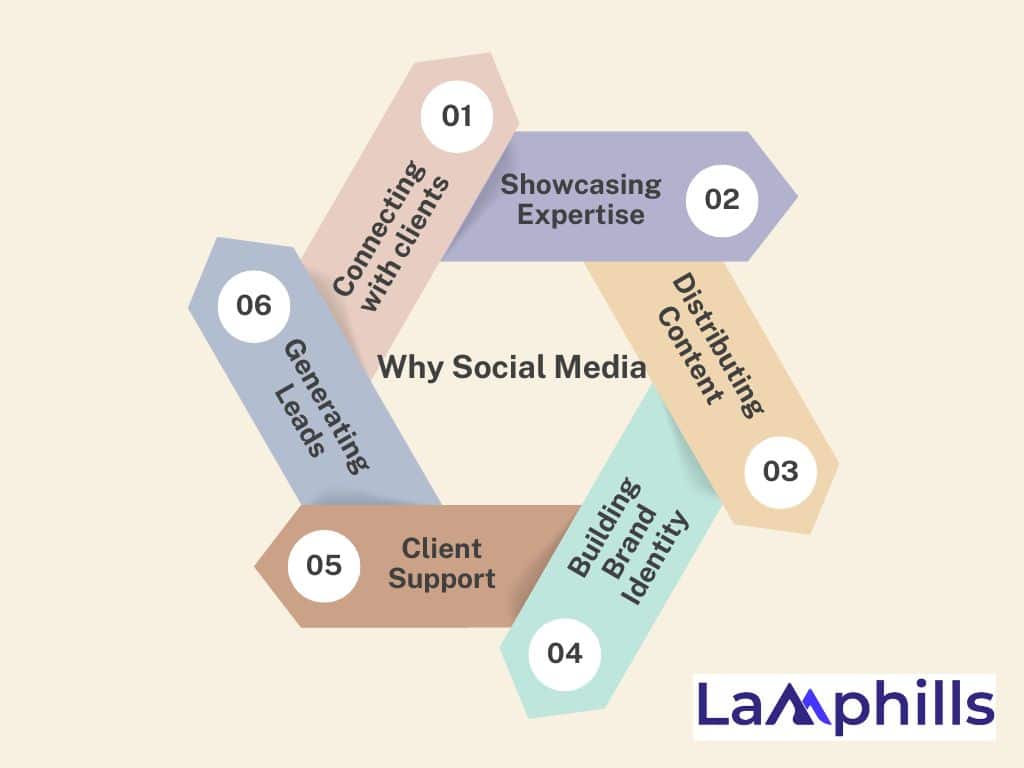B2B businesses show that any company can succeed on social media. How? By leveraging B2B social media strategies, they’ve made a specialized industry that is usually less exciting into a space for creative social content.
When I think of B2B companies with a strong social media presence, a few examples come to mind: IBM, Google, HubSpot, and others. These companies do a great job sharing content that attracts and grows their audience. They focus on engaging followers rather than constantly promoting their products or services.
Platforms like Facebook and Twitter have become a big part of people’s lives over the years. This makes them a great place to promote your business because you can reach a large audience.
But what is B2B social media marketing? How does it work, and how can you make it better? We’ll answer all these questions below, so keep reading to find out more.
First, let’s understand what B2B social media strategy is and why it is important for your company.
Key Points
- Social media is essential for networking and building relationships with clients in the B2B space.
- B2B companies can use social media to demonstrate their expertise by sharing industry insights, case studies, and success stories, positioning themselves as leaders in their field.
- A consistent and well-maintained social media presence helps in shaping the brand’s identity, making it as important as the company website or face-to-face interactions.
- Content that resonates with the target audience can attract potential clients who are genuinely interested in the business.
- Active participation in social media is crucial for staying competitive in the B2B industry.
What Is a B2B Social Media Strategy?
A B2B (Business-to-Business) social media strategy is a plan that companies use to connect with other businesses through social media platforms like LinkedIn, Twitter, and Facebook. Unlike B2C (Business-to-Consumer) strategies, which focus on reaching individual customers, B2B strategies are all about building relationships with other companies.
This could mean anything from creating content that speaks directly to the needs of other businesses, engaging in industry-specific conversations, or showcasing your company’s expertise to attract potential partners or clients.
For a B2B company to succeed on social media, its content must balance being interesting and not interrupting the audience’s experience. Ultimately, these companies need to understand what their audience wants to see in order to benefit from social media.
To connect with and attract your audience, consider these strategies used by B2B companies, which could help your social accounts succeed.
Why Is Social Media So Valuable for B2B Companies?

You might not see social media as the best strategy for a B2B company. After all, you’re selling to businesses, not directly to people. So, why focus on platforms meant for individual users?
Even though you’re targeting businesses, those businesses are run by people, and most of them are on social media. So, using social media for B2B companies can still be a good strategy, and here’s why:
#1. Connecting with clients
It’s common and part of most professionals’ work routine for networking. If your competitors are on social media, your clients are likely there, too. A strong social media presence and good engagement, along with a clear content strategy, will make your business look good to clients and other B2B social media users.
#2. Showcasing Expertise
Social media is a great platform for B2B companies to demonstrate their expertise. By sharing industry insights, case studies, and success stories, a company can position itself as a leader in its field. I remember when we posted an article on LinkedIn about a new technology we had developed. It wasn’t just a regular post; it was a detailed case study that showed how our solution had helped another company improve its operations. That post led to several inquiries from other businesses that were facing similar challenges.
#3. Distributing Content
Content is an important factor we track on Elevate. Social media platforms are great for sharing educational content, like articles, white papers, and blog posts. This helps attract potential customers to your site and can be the first step in your marketing process.
Trust built through quality content is often key for business people when buying. That’s why it’s a good idea to use social platforms to share content like customer success stories, testimonials, event streams, or video tutorials showcasing your expertise.
#4. Building Brand Identity
Your social media presence gives people a real and authentic view of your business, showing who you are and what you stand for. It can be just as important as your website or even meeting in person. Every social media post plays a role in shaping your brand’s image — how you want B2B buyers, potential customers, talent, and investors to see you. With a strong social media presence and a focused, relevant content strategy, you can establish and maintain your business’s reputation as a leader in your field. This can be a powerful tool for B2B marketing.
Employee involvement is a key benefit; they are your true brand advocates. When company culture is positive and visible, employees sharing their work experiences and meaningful activities create effective content. This also makes it easier to attract top talent. Employee advocacy can strengthen relationships with customers, as people prefer doing business with those who are passionate about their work.
#5. Client Support
Social media is a powerful tool for customer support. Clients can quickly and publicly let you know when something goes wrong with your product or service. These interactions allow your company to address issues fast, show the quality of your customer service, and protect your reputation. Many people prefer using social media for support, so making it a key part of your PR, communication, and customer service strategy is important.
While every business, whether B2B or B2C, should try to avoid problems, handling issues efficiently on social media can greatly influence a customer’s decision to buy from you. Good service and quick problem-solving build stronger customer relationships.
#6. SEO
Links from other websites, mentions, and interest in a company’s content all help with SEO. As we know from Elevate, ranking high on search engines is crucial for business success. We’ll discuss SEO in more detail in another post because it’s one of Elevate’s key ways to measure how well a business does online. Social media is an easy way to manage, influence, and update many parts of SEO to keep a business ranking high in search engines.
#7. Generating Leads
Social media isn’t just about likes and shares; it’s also a powerful tool for generating leads. By sharing content that resonates with your target audience, you can attract potential clients genuinely interested in your offer. In my experience, some of our best leads have come from LinkedIn posts where we discussed industry trends and offered solutions.
#8. Staying Competitive
Lastly, being on social media helps B2B companies stay competitive. If your competitors are active on social media and you’re not, you risk falling behind. I’ve learned that keeping up with industry trends and being part of the online conversation is crucial for staying relevant.
Now that we understand the importance of B2B social media, the next question is: How can you use it effectively? What must you do to create a successful B2B social media strategy?
Tips For B2B Social Media Success

Below, we’ve put together a list of B2B social media tips that your business can use to get more leads and sales.
Here are six ways to make your B2B social media strategy better:
#1. Set SMART Goals.
Like any other marketing approach, a social media strategy needs clear goals to be effective. Setting specific and measurable key performance indicators (KPIs) for your social media efforts, whether focusing on brand awareness or gaining new customers, will help you track success.
To set KPIs, first, decide what success looks like for your brand. Are you using social media to attract new customers? Do you want to increase your audience or drive more traffic to your blog? Your answer will determine which metrics to monitor.
For example, to generate leads, focus on metrics like clicks and conversions. If brand awareness is your goal, pay attention to engagement, reach, and impressions.
Here’s an example of a SMART goal for a company starting to grow on social media:
Goal: Build brand awareness on social media.
Specific: I want to increase our company’s brand awareness by posting regularly on Twitter, Instagram, LinkedIn, and Facebook. Our content creators will go from making two posts a week to three, and our designer will create two visual assets per week instead of one.
Measurable: Our goal is to achieve a 4% increase in engagement across all platforms.
Attainable: Last month, our engagement rate increased by 2% when we posted more often and focused on creating engaging content.
Relevant: By increasing engagement, we’ll raise brand awareness and generate more leads, providing our sales team with more opportunities.
Time-Bound: By the end of this month.
SMART Goal: By the end of this month, we aim to increase our average engagement rate by 4% across all social media channels by posting more frequently and focusing on creating engaging content.
#2. Know your target audience
Simply posting content online without a clear target is a quick way to miss your audience. When creating a social media strategy, focus on understanding your ideal customers. This will help you identify the right audience for your social media campaign and create content that resonates with them, engages them, and generates quality leads. Knowing your audience also helps shape the content’s tone, style, and visual elements.
After setting project goals and identifying your target audience, your company’s B2B or social media marketers should develop a content calendar. This calendar outlines what content will be posted and when keeping your social media efforts organized and effective.
#3. Watch your competitors
Social media gives you a glimpse into your competitors’ marketing strategies, especially their social media activities. For larger businesses, keeping track of competitors is essential. You want to see what campaigns they’re running and how successful they are. You can learn from their approach if their target audience is similar to yours.
However, watching your competitors isn’t about copying them. Being in the same industry means your audiences and their interests might overlap. If you notice your competitor isn’t reacting to trending news, it could be an opportunity for your brand to step in. Finding these opportunities can help you stand out from the competition.
#4. Choose the right social media platform
For most B2B companies, platforms like Facebook, Instagram, or Pinterest might not be the best fit unless they rely heavily on visual content and design. However, this decision should always be based on understanding your audience’s behavior, data insights, and expected engagement. LinkedIn is the top platform for B2B companies and should be the main focus of any B2B content strategy. It’s the best place for professional and business-related content, with high levels of employee engagement and a large pool of potential customers. Twitter is also valuable for sharing news and content and providing client support. When building a B2B social media strategy, LinkedIn and Twitter should be where you spend the most time and effort.
YouTube can also be a powerful tool for sharing educational videos, product demos, feature presentations, targeted ads, and company showcase videos. However, video creation is usually more costly than written content, so it’s important to evaluate if the investment will pay off in terms of return on investment (ROI). Video content can be highly effective because it’s easy to access, impactful, and shareable.
#5. Share original content.
It might seem obvious, but many businesses rely on sharing content from other sources to build their social media presence. However, your audience can easily spot the difference between original, creative content and something posted just to appear active.
Social media isn’t just for sharing other people’s content. Social media marketers should also focus on creating their own content to make a real impact on their brand.
If you’re struggling to come up with original content every day, it’s okay to post less often. If you can’t manage to post on every platform, focus your efforts on the channels where your audience is most active.
#7. Use multimedia
Social media marketers get excited when a platform introduces a new feature because it offers a fresh way to engage with the audience.
Examples like Instagram Stories, Twitter polls, and LinkedIn documents show how each platform has its own unique multimedia formats.
By creating and sharing different types of content on your social media channels, you make your posts more interesting and grab your audience’s attention.
Imagine scrolling through Twitter and only seeing text posts—it would get boring fast. What makes Twitter so engaging is the variety in the content. In just a few seconds, you might see a meme, a poll, a video, a photo collage, and a gif. Your brand’s social media should have that same mix.
When you create social media content, think not just about the message but also about the different ways you can share it.
#8. Highlight Your Employees
Many B2B companies do a great job of showing off their employees, helping the audience connect faces with the company, and making the brand feel more personal. This approach works for both small and large businesses because no matter what you sell—whether it’s computers or restaurant service, people are the core of your business.
Also, showcasing your employees is a great way to boost your employer branding. It helps your team feel proud of where they work and encourages them to spread the word about your company.
Sharing photos or stories about your staff can also increase your reach and engagement. For example, instead of just posting a product photo, you could share a picture of the team who made the product. Those team members are likely to share it with their own networks, expanding your audience.
#9. Develop a Distinct Brand Voice
Whenever your company writes a blog, updates a webpage, or posts on social media, it’s a chance to show off your brand’s personality. Just as people recognize your logo, they should also be able to recognize your brand’s voice.
Your social media content should reflect your company’s style and values. Does your brand like to be funny or offer helpful advice? Take a cue from popular brands like Burger King or Wendy’s, known for their unique, consistent voices on social media.
Your brand voice doesn’t have to be humorous; it can be friendly, formal, casual, or anything else that suits your brand. If you’re not sure what your voice is, look at some of your past blog posts or website content. Notice the tone and emotions they convey, and aim to carry that into your social media messaging.
Having a unique brand voice can help you stand out in a crowded market.
#10. Provide Support
It’s really frustrating for customers when they tweet a brand with a problem and don’t get a response. Even if you can’t set up a separate Twitter account just for support, make sure you’re watching for these issues and respond quickly. This is a great way to fix the relationship with the customer and show others that your company will be there for them if they have a problem in the future.
#11. Stay Consistent
One of the toughest parts about social media is staying consistent. Posting on every channel daily takes a lot of time, planning, and content creation. If you’re just starting out, focus on making quality content that adds value to your audience’s feed rather than posting every day. It’s better to share one thoughtful tweet that sparks conversation and encourages engagement than five quick posts with just a title.
Another way to stay consistent is by creating a posting calendar and scheduling your posts in advance using social media tools.
#12. Try Different Content and Posting Times
Once you’ve established a regular posting routine, you can start experimenting to understand your audience better. While there are general guidelines for what and when to post, every audience is different, so it’s important to test what works best for your brand.
Here are some ideas for experiments you can run:
- Use questions or statistics in your posts and see which gets more engagement.
- Test different link placements to see if it affects click rates.
- Add emojis to your posts and observe if it boosts interactions.
- Post more or less frequently to find the optimal frequency.
- Compare the performance of a paid video post versus a still image.
- Segment your audience and test how different groups respond to ads.
- Experiment with different numbers of hashtags to see if it changes your reach.
- Spend more time replying to comments to see if it increases your followers.
Experimenting helps you discover what works best for your brand, making your strategy more tailored than general industry advice.
#13. Engage in Conversation
Social media was made for people to connect with each other. Even though brands have taken over much of the space, this purpose remains the same.
Your brand won’t connect with people if all you do is push your products at them. It’s disruptive, and no one wants to engage with content that doesn’t fit their social feed.
To stay relevant, participate in conversations your target audience cares about—even if they aren’t directly related to your product.
#14. Monitor and Measure Performance
When running a campaign, it’s important to regularly check its performance to ensure that you’re hitting your goals.
By looking at metrics like engagement, reach, and conversion rates, you can see what’s working well and what needs improvement. This approach helps you make smart decisions to improve your social media efforts and get better results for your business.
Also, by regularly checking performance, you can track your progress and make changes to stay competitive. This way, you can refine your social media strategy and succeed with your B2B projects.
Creating a B2B social media strategy can help your business connect with other companies, build relationships, and grow your brand online. This template will guide you step-by-step in setting clear goals, understanding your audience, planning content, and measuring success.
By following this template, you’ll have a solid B2B social media strategy that helps your business reach the right people, share valuable content, and achieve your goals. Remember, social media is about consistency and engagement, keep refining your approach to see the best results.
Wrap UP
In conclusion, these 10+ B2B social media strategies offer practical ways to enhance your business’s online presence and connect with your audience. By implementing these tactics, you can build stronger relationships, increase brand awareness, and drive more leads. Remember, consistency is key, and with the right approach, your social media efforts can lead to significant growth for your business. Start applying these strategies today and watch your business thrive!
Bonus Answers to FAQs
What is a B2B social media strategy?
B2B social media marketing involves using social networks to connect with both potential and current business clients. This strategy includes sharing relevant industry content, networking, and having conversations that showcase your expertise.
How to Create a B2B Social Media Strategy?
Building a B2B social media strategy requires careful planning. This means paying attention to what your team posts, connecting with industry experts, and engaging with your audience and potential customers.
Which social media is best for B2B?
LinkedIn, Facebook, and Instagram work well for B2B social media. LinkedIn is the best for getting traffic and leads. Instagram, YouTube, and TikTok are great for connecting with younger audiences and boosting brand engagement through pictures and videos.
How can I get large B2B clients?
8 Simple Ways to Get B2B Clients for Your Business
1. Contact potential clients through cold outreach.
2. Use your website to attract B2B leads.
3. Leverage social media to build relationships and sell.
4. Attend in-person events to connect directly with people.
5. Ask happy clients for referrals.
6. Host podcasts and webinars to share your expertise.
7. Join online groups and forums (like Reddit, Quora) to engage with your audience.
8. Partner with influencers to broaden your reach.
What is an example of B2B?
Business-to-business (B2B) refers to transactions between businesses, such as when one company sells raw materials to another or when a manufacturer sells products to a wholesaler. An example of B2B is a wholesaler selling goods to a retailer or a manufacturer selling to a wholesaler.
What are the best B2B products to sell?
Here’s a list of the top-selling products
– Subscription services
– Headphones
– Fashion accessories
– Water bottles
– Eco-friendly and sustainable products
– Fitness and health tech products
– Home goods
– Hair care products
Similar Articles
Mastering B2B Online Marketing: Strategies, Trends, and Insights
Top 10 Corporate Social Responsibility Strategies for 2024: A Guide for Modern Businesses
What is B2B PR? How it Works and What to Expect from a B2B Public Relations Agency






